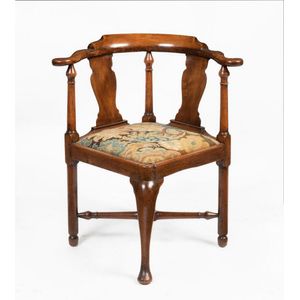18th Century Georgian Elm Corner Chair with Tapestry Seat
A Georgian elm provincial corner chair, 18th century, with vasiform splats, a tapestry drop in seat, the legs united by turned cross stretchers
You must be a subscriber, and be logged in to view price and dealer details.
Subscribe Now to view actual auction price for this item
When you subscribe, you have the option of setting the currency in which to display prices to $Au, $US, $NZ or Stg.
This item has been sold, and the description, image and price are for reference purposes only.
- Georgian - As an English stylistic period, Georgian is usually taken to cover the period from George I (1714) to the Regency of Prince George (1811-20), although the period from 1800 to 1830 is sometimes designated as the Regency period. During the Georgian period the great English cabinetmakers and designers such as Chippendale, Hepplewhite, Adam Sheraton etc., were all active.
Therefore there isn't a single 'Georgian style' as such and to say something is 'Georgian', usually means it was made between 1714 and 1830. This assumes we discount George V and George VI, both being from the 20th century.
The styles popular at the time of each reign were:
George I (1714-1727) saw out the last years of the Baroque period.
George II (1727-1760) reigned during the Rococo period.
George III (1760-1820) saw the last gasp of the Rococo, all of the early Neo-Classic 'Adam style' and most of the later neo-Classic 'Regency style'.
George IV (Prince Regent 1820-1830)encompassed the last of the 'Regency' style.
William IV's reign (1830-1837) was something of a no man's land (stylistically) and he wasn't a 'George' anyway. He covered the last glimmerings of 'Regency' and the start of the 'Victorian' style. - Drop in Seat - Mostly used on Regency upright chairs, a drop in (or "drop on") seat is an unsprung removable seat where the upholstery is attached to a wooden frame, which is held in place by the sides of the chair, and usually a wooden peg at the front of the chair. An inset upholstered seat is of the same construction, but it sits within a frame whose perimeter includes four sides of the chair.
Because the upholstery frame was not very deep, the seats were relatively uncomfortable. In the mid 19th century coiled upholstery springs came into use and frame of the chair was used as the upholstery frame, making for a much more comfortable and responsive seat.
This type of seat was known as an over-upholstered or over-stuffed seat. - Turning - Any part of a piece of furniture that has been turned and shaped with chisels on a lathe. Turned sections include legs, columns, feet, finials, pedestals, stretchers, spindles etc. There have been many varieties and fashions over the centuries: baluster, melon, barley-sugar, bobbin, cotton-reel, rope-twist, and so on. Split turning implies a turned section that has been cut in half lengthwise and applied to a cabinet front as a false decorative support.
This item has been included into following indexes:
- chairs, singles - Georgian 553
- chairs, singles / pairs / threes, style or period
